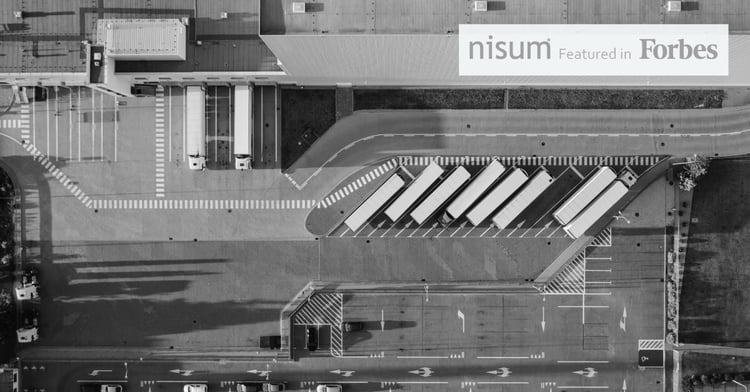As business leaders have realized blockchain's massive potential, Nisum EVP shares his thoughts on why supply chain is ripe for blockchain disruption -- from back-end inventory management processes all the way to front-end customer experiences in this Forbes article, "Three Ways Blockchain Is Disrupting Supply Chains (And None Of Them Are Bitcoin)". Read it on Forbes or continue reading below for the full article.

Bitcoin’s unprecedented boom in 2017 -- and subsequent bust in 2018 -- made blockchain a household name. However, the technologists who have been working with and developing blockchain since it first debuted in 2008 have likely long realized that the advance in software architecture that it represents has long-lasting implications far beyond cryptocurrency.
Today, we are beginning to see some of those implications come to life. Across industries and verticals, many business leaders have realized that blockchain has massive potential to upend and streamline supply chain operations. As the executive vice president of growth and delivery at a company that offers blockchain services, I believe the supply chain is ripe for blockchain disruption -- from back-end inventory management processes all the way to front-end customer experiences.
Why Supply Chain?
Before we delve into some of the most innovative ways companies are using blockchain, it’s worth revisiting how we got to where we are today.
Blockchain eliminates the need for many third-party intermediaries that exist to ensure the security and authenticity of a transaction. This lends itself quite well to cryptocurrency. Financial transactions between multiple parties are securely facilitated through blockchain’s transparent, verifiable and immutable ledger, which allows users to bypass banks, credit card companies, and other traditional financial institutions. Essentially, blockchain is a way for two or more parties who don’t know or trust each other to directly transact with more confidence.
A supply chain is a series of transactions between multiple parties, including manufacturing, procurement, wholesale, retail, inventory, shipping, stores, consumers, and so on. With many organizations, countries, and regulations involved, I've noticed that these transactions have traditionally suffered from a lack of transparency. This is inefficient at best and potentially dangerous for consumers at worst.
As such, there’s a huge potential for blockchain to introduce a more efficient way for supply chain ecosystems to record and share information.
Blockchain In The Real World
With that understanding, we can take a look at some real-world examples of how blockchain is changing business as usual for supply chain operations.
Ethical Sourcing
What do farm-to-table, a social movement that has spawned a new generation of eateries, and blockchain, a deeply complex technology related to software architecture, have in common? The practice of ethically sourcing ingredients by tracking the journey from where they originate (farm) to where they end up (table) is actually the perfect use case for blockchain.
In fact, Starbucks recently announced a blockchain system to track its beans from “farm to cup.” Blockchain will give consumers access to details on where their beans were sourced and roasted, while growers will be able to see data around where their products end up.
Product Recalls
Limited visibility into where products have been and when can be hugely detrimental when people’s health and safety are at risk. Whether it’s a defective infant car seat or contaminated spinach at the grocery store, retailers need to know exactly where in the supply chain the contamination or defect occurred in order to remove dangerous products from the market and identify other affected products.
Walmart was one of the first retailers to implement blockchain for its live food business (paywall), and others like Danone are following suit with blockchain systems to track food provenance.
Fraud Prevention
From fine wines to designer handbags, fraud runs rampant in the market for luxury goods. Counterfeit wines alone could account for billions of dollars of false products, according to one expert's estimate; there was even a Netflix documentary made about one man’s ability to swindle the most elite wine collectors in the world for millions of dollars over many years.
This type of fraud likely wouldn’t be possible using blockchain. By borrowing from Starbucks’ “farm to cup” initiative, it’s easy to see how winemakers could translate this into a similar “vineyard to glass” blockchain-based supply chain to ensure the integrity of each bottle’s contents. Companies like EY are reportedly building blockchain platforms to make this possible.
Across luxury retail goods, RFID tags and sensors can effectively and veritably track the production of handbags, clothes, shoes, and other goods to ensure their brand integrity, mirroring the degree of supply chain visibility described above. This could become increasingly important with the rise of e-commerce sites for second-hand luxury goods, such as Depop or The RealReal; sellers can show their goods are actually from the brands they claim, and buyers can rest assured that they are getting what they paid for.
Smart contracts, one of the first use cases for blockchain, certainly apply here as well. Smart contracts fulfill payment agreements one step at a time and don't move forward to the next step until the previous step has been verified. For example, a consumer purchases a Prada handbag secondhand. Their payment is held until the package has been noted on the blockchain ledger as shipped from the seller. With this immutable digital footprint, it would be much more difficult to deceive consumers.
Looking Forward
Blockchain could potentially eliminate the fraud problem plaguing the luxury goods sector, and companies could apply it more broadly throughout the retail environment to streamline supply chain operations with increased transparency. We have, however, only begun to scratch the surface of blockchain’s potential. Cost and scale currently pose some of the biggest challenges in implementing blockchain on a widespread basis for retail, though as sidechain technology becomes more sophisticated, we may begin to address the challenges related to scaling.
These are just some of the use cases for how blockchain can be applied to improve supply chain operations. Through a single, verifiable, immutable, and open record of each movement in the supply chain, blockchain can provide an uncorrupted and comprehensive view of a product’s journey from start to finish, across countries, through different organizations, and into the hands of consumers.



